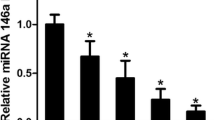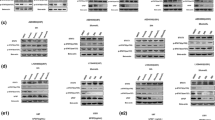Abstract
Transforming growth factor beta (TGF-β) is suggestive of a molecular target for cancer therapy due to its involvement in cell cycle, differentiation, and morphogenesis. Meanwhile, survivin is identified as an apoptosis inhibitor and involved in tumorgenesis. Here, we aimed to investigate the potential associations between TGF-β and survivin in glioblastoma U87 cell line. Survivin small interfering RNA (siRNA), Western blotting, and cell cycle analysis were introduced to detect relevant proteins in TGF-β pathways. In this study, we observed a concentration- and time-dependent increase of survivin expression after treatment with TGF-β1. However, the kinase inhibitors U0126 and LY294002 inhibited the upregulation of survivin in comparison with DMSO. In addition, survivin siRNA effectively abrogated survivin expression in U87 cells, therefore affected cells’ entry into the S phase of cell cycle, and then repressed the expression of epidermal growth factor receptor (EGFR) and matrix metalloproteinase 9 (MMP9) in comparison with non-transfection. In conclusion, the present study shows that TGF-β upregulates survivin expression via ERK and PI3K/AKT pathway, leading to glioblastoma cell cycle progression. Thus, the blockade of survivin will allow for the treatment of glioblastoma, partially attributing to the inhibition of EGFR and MMP9 expression.




Similar content being viewed by others
References
Buckner JC (2003) Factors influencing survival in high-grade gliomas. Semin Oncol 30(6 Suppl 19):10–14
Stupp R, Mason WP, van den Bent MJ, Weller M, Fisher B, Taphoorn MJ, Belanger K, Brandes AA et al (2005) Radiotherapy plus concomitant and adjuvant temozolomide for glioblastoma. N Engl J Med 352(10):987–996
Woodworth GF, Dunn GP, Nance EA, Hanes J, Brem H (2014) Emerging insights into barriers to effective brain tumor therapeutics. Front Oncol 4:126
Walker MD, Alexander E Jr, Hunt WE, MacCarty CS, Mahaley MS Jr, Mealey J Jr, Norrell HA, Owens G et al (1978) Evaluation of BCNU and/or radiotherapy in the treatment of anaplastic gliomas. A cooperative clinical trial. J Neurosurg 49(3):333–343
Walker MD, Green SB, Byar DP, Alexander E Jr, Batzdorf U, Brooks WH, Hunt WE, MacCarty CS et al (1980) Randomized comparisons of radiotherapy and nitrosoureas for the treatment of malignant glioma after surgery. N Engl J Med 303(23):1323–1329
Parsa AT, Waldron JS, Panner A, Crane CA, Parney IF, Barry JJ, Cachola KE, Murray JC et al (2007) Loss of tumor suppressor PTEN function increases B7-H1 expression and immunoresistance in glioma. Nat Med 13(1):84–88
Nagasawa DT, Chow F, Yew A, Kim W, Cremer N, Yang I (2012) Temozolomide and other potential agents for the treatment of glioblastoma multiforme. Neurosurg Clin N Am 23(2):307–322
Sporn MB, Roberts AB (1992) Transforming growth factor-beta: recent progress and new challenges. J Cell Biol 119(5):1017–1021
Blobe GC, Schiemann WP, Lodish HF (2000) Role of transforming growth factor beta in human disease. N Engl J Med 342(18):1350–1358
Gao J, Zhu Y, Nilsson M, Sundfeldt K (2014) TGF-β isoforms induce EMT independent migration of ovarian cancer cells. Cancer Cell Int 14(1):72
Gonzalez DM, Medici D (2014) Signaling mechanisms of the epithelial-mesenchymal transition. Sci Signal 7(344):re8
Liu RY, Zeng Y, Lei Z, Wang L, Yang H, Liu Z, Zhao J, Zhang HT (2014) JAK/STAT3 signaling is required for TGF-β-induced epithelial-mesenchymal transition in lung cancer cells. Int J Oncol 44(5):1643–1651
Takai E, Tsukimoto M, Kojima S (2013) TGF-β1 downregulates COX-2 expression leading to decrease of PGE2 production in human lung cancer A549 cells, which is involved in fibrotic response to TGF-β1. PLoS One 8(10):e76346
Cho KH, Jeong KJ, Shin SC, Kang J, Park CG, Lee HY (2013) STAT3 mediates TGF-β1-induced TWIST1 expression and prostate cancer invasion. Cancer Lett 336(1):167–173
Li W, Chen YQ, Shen YB, Shu HM, Wang XJ, Zhao CL, Chen CJ (2013) HIF-1α knockdown by miRNA decreases survivin expression and inhibits A549 cell growth in vitro and in vivo. Int J Mol Med 32(2):271–280
Guha M, Altieri DC (2009) Survivin as a global target of intrinsic tumor suppression networks. Cell Cycle 8(17):2708–2710
Lladser A, Sanhueza C, Kiessling R, Quest AF (2011) Is survivin the potential Achilles’ heel of cancer? Adv Cancer Res 111:1–37
Travis RC, Reeves GK, Green J, Bull D, Tipper SJ, Baker K, Beral V, Peto R et al (2010) Gene-environment interactions in 7610 women with breast cancer: prospective evidence from the Million Women Study. Lancet 375(9732):2143–2151
Sánchez-Elsner T, Botella LM, Velasco B, Corbí A, Attisano L, Bernabéu C (2001) Synergistic cooperation between hypoxia and transforming growth factor-beta pathways on human vascular endothelial growth factor gene expression. J Biol Chem 276(42):38527–38535
Ravikumar G, Ananthamurthy A (2014) Cyclin D1 expression in ductal carcinoma of the breast and its correlation with other prognostic parameters. J Cancer Res Ther 10(3):671–675
Rekhi B, Motghare P (2014) Cyclin D1 and p16INK4 positive endometrial stromal sarcoma: a case report with new insights. Indian J Pathol Microbiol 57(4):606–608
Li T, Zhao X, Mo Z, Huang W, Yan H, Ling Z, Ye Y (2014) Formononetin promotes cell cycle arrest via downregulation of Akt/Cyclin D1/CDK4 in human prostate cancer cells. Cell Physiol Biochem 34(4):1351–1358
Soppa U, Schumacher J, Florencio Ortiz V, Pasqualon T, Tejedor FJ, Becker W (2014) The Down syndrome-related protein kinase DYRK1A phosphorylates p27(Kip1) and Cyclin D1 and induces cell cycle exit and neuronal differentiation. Cell Cycle 13(13):2084–2100
Yang Y, Ma B, Li L, Jin Y, Ben W, Zhang D, Jiang K, Feng S et al (2014) CDK2 and CDK4 play important roles in promoting the proliferation of SKOV3 ovarian carcinoma cells induced by tumor-associated macrophages. Oncol Rep 31(6):2759–2768
Kokontis JM, Lin HP, Jiang SS, Lin CY, Fukuchi J, Hiipakka RA, Chung CJ, Chan TM et al (2014) Androgen suppresses the proliferation of androgen receptor-positive castration-resistant prostate cancer cells via inhibition of Cdk2, CyclinA, and Skp2. PLoS One 9(10):e109170
Ahn SH, Jeong EH, Lee TG, Kim SY, Kim HR, Kim CH (2014) Gefitinib induces cytoplasmic translocation of the CDK inhibitor p27 and its binding to a cleaved intermediate of caspase 8 in non-small cell lung cancer cells. Cell Oncol (Dordr) 37(5):377–386
García I, Vizoso F, Andicoechea A, Fernandez P, Suarez C, García-Muñz JL, Allende MT (2000) C-erbB-2 oncoprotein content in gastric cancer and in adjacent mucosa. Int J Biol Markers 15(3):231–234
Shun CT, Wu MS, Lin JT, Chen SY, Wang HP, Lee WJ, Wang TH, Chuang SM (1997) Relationship of p53 and c-erbB-2 expression to histopathological features, Helicobacter pylori infection and prognosis in gastric cancer. Hepatogastroenterology 44(14):604–609
Dan L, Jian D, Na L, Xiaozhong W (2012) Crosstalk between EGFR and integrin affects invasion and proliferation of gastric cancer cell line, SGC7901. Onco Targets Ther 5:271–277
Sarosiek J, Bilski J, Murty VL, Slomiany A, Slomiany BL (1988) Role of salivary epidermal growth factor in the maintenance of physicochemical characteristics of oral and gastric mucosal mucus coat. Biochem Biophys Res Commun 152(3):1421–1427
Kessenbrock K, Plaks V, Werb Z (2010) Matrix metalloproteinases: regulators of the tumor microenvironment. Cell 141(1):52–67
Acknowledgments
This work is supported by the National Natural Science Foundation of China (grant no. 81402926 to Dr. Wenliang Chen) and Youth Program from Guangzhou City Bureau of Education (no. 2012C204 to Dr. Wen-liang Chen). We gratefully thank other members of Sandy Lab for their critical reading of this paper and valuable suggestions.
Conflicts of interest
The authors declare no conflict of interest.
Author information
Authors and Affiliations
Corresponding author
Additional information
This article has been retracted at the request of the Editor-in-Chief and the Publisher per the Committee on Publication Ethics guidelines. There is strong reason to believe that the peer review process was compromised and the authors have plagiarized parts from the following articles:
Anyan Liao, Ranran Shi, Yuliang Jiang, Suqing Tian, Panpan Li, Fuxi Song, Yalan Qu, Jinna Li, Haiqin Yun, Xiangshan Yang, SDF-1/CXCR4 Axis Regulates Cell Cycle Progression and Epithelial-Mesenchymal Transition via Up-regulation of Survivin in Glioblastoma, Molecular Neurobiology, January 2016, Volume 53, Issue 1, pp 210–215, DOI: 10.1007/s12035-014-9006-0
Received: 1 November 2014
Peng Yang, Gang Wang, Hongjun Huo, Qiang Li, Yan Zhao, Yuanhang Liu, SDF-1/CXCR4 signaling up-regulates survivin to regulate human sacral chondrosarcoma cell cycle and epithelial–mesenchymal transition via ERK and PI3K/AKT pathway, Medical Oncology, January 2015, 32:377, DOI: 10.1007/s12032-014-0377-x
Received: 13 November 2014
As such, the validity of the content of this article cannot be verified
An erratum to this article is available at http://dx.doi.org/10.1007/s12035-017-0581-8.
About this article
Cite this article
Chen, W., Zhong, X., Wei, Y. et al. RETRACTED ARTICLE: TGF-β Regulates Survivin to Affect Cell Cycle and the Expression of EGFR and MMP9 in Glioblastoma. Mol Neurobiol 53, 1648–1653 (2016). https://doi.org/10.1007/s12035-015-9121-6
Received:
Accepted:
Published:
Issue Date:
DOI: https://doi.org/10.1007/s12035-015-9121-6




